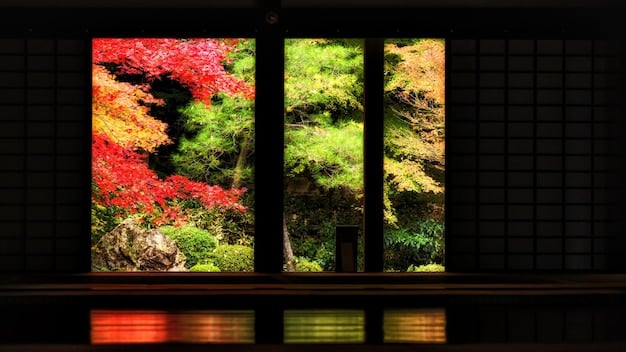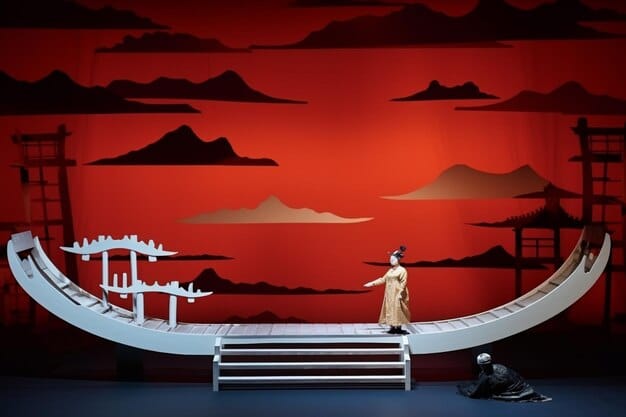Japanese Drama Influence on US TV: Similarities & Differences

Advertisements
The influence of Japanese dramas on US television is evident through shared storytelling elements, character archetypes, and thematic explorations, though cultural differences lead to variations adapting narratives to unique audience expectations.
The world of television is constantly evolving, with influences coming from unexpected corners of the globe. One significant yet often understated influence is the **Japanese Drama Influence on US Television: Spotting the Similarities and Differences**. Let’s dive into how these distinct storytelling traditions compare and contrast.
Anúncios
Understanding the Global Appeal of Japanese Dramas
Japanese dramas, often called “dramas” or “J-dramas,” have captured the hearts of viewers worldwide. Their unique storytelling style, rich character development, and exploration of relevant social issues have made them popular beyond Japan’s borders. This global appeal has gradually led to noticeable elements seeping into US television.
Exploring the specific elements that make J-dramas so captivating is essential to understanding their influence. From the intricate plots and emotional performances to the cultural nuances that shape the narratives, there’s a lot to appreciate, and subsequently, a lot that can be adapted.
Anúncios
Key Elements of J-Drama Appeal
Several key features contribute to the broad appeal of Japanese dramas, making them attractive for adaptation or influence in other markets.
- Visual Storytelling: J-dramas often employ striking visual techniques, focusing on emotions through cinematography.
- Character-Driven Narratives: The depth of character development is a strong point, often exploring individual struggles and growth in ways that viewers find relatable.
- Thematic Depth: Many J-dramas delve into social issues, ethical dilemmas, and personal conflicts, providing substance that resonates with a diverse audience.
Ultimately, the blend of emotional depth, cultural specificity, and universal themes is what makes these series stand out and become increasingly influential worldwide.

Tracing the Roots: The History of Japanese Drama
The history of Japanese dramas is multifaceted, evolving from theatrical roots to the modern television series we know today. Understanding this timeline is critical to appreciate its transformation and the nuances that make it so influential.
From traditional Kabuki and Noh theater to the rise of television in the mid-20th century, Japanese dramas have mirrored and shaped Japanese culture, which has prepared them for a more recent leap onto the world stage.
Key Historical Milestones
The evolution of J-dramas is dotted with major milestones that have defined their current form.
- Post-War Era: Early dramas focused on national identity and recovery, often reflecting the socio-economic changes Japan was undergoing.
- The Golden Age: In the 1980s and 90s, J-dramas saw a boom in popularity, exploring themes like love, family, and career with relatable characters.
- Digital Revolution: The advent of the internet and streaming services broadened the reach of J-dramas, making them accessible worldwide and impacting global television trends.
These historical phases not only highlight the adaptive nature of J-dramas but also explain how they’ve cultivated a distinct identity that now influences global television, including US television.
Spotting Similarities in Narrative Structures
When comparing Japanese dramas and US television shows, one can easily identify parallels in narrative structures. This isn’t coincidental; many US shows consciously or unconsciously adopt effective storytelling techniques common in successful J-dramas.
Understanding these shared structures helps to highlight the universality of good storytelling while also appreciating the unique cultural twists each adds to these frameworks.

Divergences and Cultural Adaptations
While many similarities exist, divergences are equally noticeable when looking at how Japanese dramas influence US television. Cultural adaptations are inevitable when transferring storylines and characters between different cultural contexts.
These adaptations reflect the specific values and preferences of the American audience, but they also reveal how underlying themes can be universal despite cultural differences.
Examples of Cultural Adaptations
Several examples show how cultural adaptation manifests when J-drama tropes are used in US television.
- Romantic Storylines: US adaptations might amplify romantic elements or alter the pacing to suit American romantic expectations.
- Family Dynamics: Differing views on family roles and responsibilities can lead to significant changes in character interactions.
- Social Issues: Sensitive topics are often handled differently, with US shows sometimes adopting a more direct or explicit approach compared to the more nuanced approach found in Japanese dramas.
These divergences showcase the creative decisions involved in making J-drama narratives resonate with US viewers while respecting the integrity of the original storylines.
Case Studies: J-Drama Influence in Popular US Shows
To better illustrate the influence of Japanese drama on US television, examining specific case studies can be illuminating. By pinpointing shows that have clearly borrowed elements or storylines, we can see the impact in concrete terms.
These case studies clarify how J-dramas have not just inspired general trends, but also directly influenced the narratives and styles of popular US television.
Notable Case Studies
Several shows stand out as examples of the integration of J-drama concepts.
- Remakes: Direct remakes of popular J-dramas have been produced in the US, adapting the scripts and characters to an American setting.
- Thematic Borrowing: Many US series borrow thematic elements or character archetypes from J-dramas without directly remaking entire plots.
- Style Influence: Visual and narrative styles, such as dramatic pauses and emotional close-ups, are increasingly common in US shows influenced by J-dramas.
The success (or occasional failure) of these adaptations highlights not only the broad appeal of J-drama constructs but also the critical role of cultural relevance in making these concepts resonate with American audiences.
The Future of Cross-Cultural Television
The cross-cultural exchange between Japanese dramas and US television is set to continue, promising a more diverse and enriched viewing experience for audiences worldwide. As global entertainment becomes more interconnected, we can expect the lines between different cultural storytelling traditions to blur further.
This trend indicates a growing appreciation for international content and a willingness to embrace new stories and styles beyond conventional Western formats. This fusion is advantageous and enriches the perspectives available to audiences, promoting a more inclusive and understanding world.
Evolving Trends
Several trends promise to shape the future of cross-cultural television.
- Increased Collaboration: Co-productions between US and Japanese studios could introduce more authentic portrayals and stories.
- Streaming Services: Platforms like Netflix and Hulu are already investing in international content, making J-dramas more accessible and visible in the US.
- Audience Demand: A growing segment of the US population is actively seeking international content, driving the demand for more diverse TV shows.
In closing, the Japanese drama influence on US television marks a major chapter in the evolution of global storytelling and signals a future where cross-cultural influences become even more commonplace, making television richer and much more reflective of the varied world we live in.
| Key Point | Brief Description |
|---|---|
| 🎭 Narrative Structures | J-dramas and US TV share storytelling techniques. |
| 🌏 Cultural Adaptations | US adaptations adjust storylines for local audiences. |
| 🎬 Case Studies | Shows with clear J-drama influences are examined. |
| 🔮 Future Trends | More collaboration and access via streaming. |
Frequently Asked Questions (FAQ)
▼
J-dramas offer unique storytelling, character depth, and exploration of social issues. Their visual style and emotive performances also create a captivating viewing experience for audiences worldwide.
▼
Cultural adaptation modifies storylines and characters to resonate with American values. This often involves altering romantic or family dynamics and handling sensitive social issues differently.
▼
US TV shows have shown signs of J-drama influence by creating direct remakes, borrowing thematic stories, and integrating J-drama visual and narrative styles, such as dramatic pauses.
▼
Streaming platforms like Netflix and Hulu increase the accessibility and visibility of J-dramas in the US, driving broader cultural exchange and reaching a wider audience base.
▼
Expect increased collaboration between US and Japanese studios, growing investments in international content by streaming services, and a rising demand from US audiences for diverse international TV offerings.
Conclusion
In summary, the Japanese drama influence on US television represents a significant cultural exchange that enriches the global entertainment landscape. From narrative similarities and cultural adaptations to increased accessibility via streaming services, J-dramas are reshaping the kinds of stories that resonate with audiences worldwide, fostering a more interconnected and diverse television experience.





